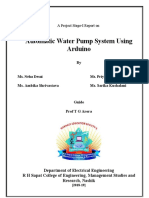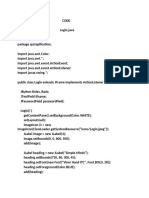Understanding Linux Memory Management SHARE 102 Session 9241
Dr. Ulrich Weigand Linux on zSeries Development, IBM Lab Bblingen Ulrich.Weigand@de.ibm.com
�Linux Memory Management - A Mystery?
What does this mean:
$ free total Mem: 512832 -/+ buffers/cache: Swap: 524280 used 473256 184180 912 free 39576 328652 523368 shared 0 buffers 52300 cached 236776
Or this:
$ cat /proc/meminfo MemTotal: 512832 MemFree: 39512 Buffers: 52308 Cached: 236768 SwapCached: 532 Active: 246328 Inactive: 61920 HighTotal: 0 HighFree: 0 LowTotal: 512832 LowFree: 39512 SwapTotal: 524280 SwapFree: 523368 kB kB kB kB kB kB kB kB kB kB kB kB kB Dirty: Writeback: Mapped: Slab: Committed_AS: PageTables: VmallocTotal: VmallocUsed: VmallocChunk: 28 0 5492 158608 7656 208 1564671 724 1563947 kB kB kB kB kB kB kB kB kB
�Agenda
Physical Memory Dynamic Address Translation Process Address Spaces and Page Cache Kernel Memory Allocators Page Replacement and Swapping Virtualization Considerations
�Physical Memory
Basic allocation unit: Page (4096 bytes)
Use of each page described by 'struct page'
Allocation status, backing store, LRU lists, dirty flag, ...
Pages aggregated into memory zones Zones may be aggregated into nodes (NUMA systems)
Boot process
Kernel loaded at bottom of memory Determine size of memory, create 'struct page' array Kernel pages and boot memory marked as 'reserved' All other pages form the master pool for page allocation
�Memory Zones
Memory not directly addressable from kernel space
On Intel machines all > 4/2/1 GB On zSeries empty
GPF_HIGHMEM ("High memory zone")
Memory generally usable by the kernel, except possibly for I/O
GPF_NORMAL ("Normal zone")
On 31-bit zSeries empty On 64-bit zSeries all > 2 GB
Memory usable without restrictions
GPF_DMA ("DMA zone")
On 31-bit zSeries all memory On 64-bit zSeries all < 2 GB (On Intel all < 16 MB)
�Kernel Memory Allocators
Low-level page allocator
Buddy system for contiguous multi-page allocations Provides pages for
in-kernel allocations (slab cache) vmalloc areas (kernel modules, multi-page data areas) page cache, anonymous user pages misc. other users
Slab cache
Manages allocations of objects of the same type Large-scale users: inodes, dentries, block I/O, network ... kmalloc (generic allocator) implemented on top
�Buddy Allocator
Order-n free lists (per zone) 0 1 2 3 4 5 6 7 8 ... MAX_ORDER 2^0 pages
2^3 pages
2^7 pages Allocate order-n block: If none is free, a order-(n+1) block is split Free order-n block: If 'buddy' is also free, merge them to order-(n+1) block
�Dynamic Address Translation: 31-bit
Segment Table Origin Segment Page Byte Index (11 bit) Index (8 bit) Index (12 bit) Virtual Address
STO
SX
PX
BX
Segment Table
Page Table
PTO
PFRA
Real Address
PFRA
Page Frame Real Address
BX
�Dynamic Address Translation: 64-bit
Region-1st Region-2nd Region-3rd Segment Page Byte Index (11 bit) Index (11 bit) Index (11 bit) Index (11 bit) Index (8 bit) Index (12 bit) Virtual Address
Region Table Origin
RFTO
RFX
RSX
RTX
SX
PX
BX
Region-1st Table
Region-2nd Table
Region-3rd Table
Segment Table
Page Table
RSTO
RTTO
STO
PTO
PFRA
Real Address
PFRA
BX
�DAT: 64-bit Three Level Translation
Region-1st Region-2nd Region-3rd Segment Page Byte Index (11 bit) Index (11 bit) Index (11 bit) Index (11 bit) Index (8 bit) Index (12 bit) Virtual Address
Region Table Origin
RTTO
RTX
SX
PX
BX
Region-1st Table
Region-2nd Table
Region-3rd Table
Segment Table
Page Table
STO
PTO
PFRA
Real Address
PFRA
BX
�zSeries Address Translation Modes
Directly accessible address spaces
Primary space: STO/RTO in Control Register 1 Secondary space: STO/RTO in Control Register 7 Home space: STO/RTO in Control Register 13 Access-register specified spaces
Access registers
Base register used in memory access identifies AR AR specifies STO/RTO via Access List Entry Token Operating System manages ALETs and grants privilege ALET 0 is primary space, ALET 1 is secondary space
�Address Translation Modes (cont.)
Translation mode specified in PSW
Primary space mode
Instructions fetched from primary space, data in primary space
Secondary space mode
Instructions in primary, data in secondary
Home space mode
Instructions and data in home space
Access register mode
Instructions in primary, data in AR-specified address space
�zSeries Program Status Word
_ _ _ _ _ _ _ _ _______ _ _ _ _ ___ ___ _______ _____________ _ | | | | | | |I|E| | | | | | | | Prog | |E| |0|R|0|0|0|T|O|X| Key |0|M|W|P|A S|C C| Mask |0 0 0 0 0 0 0|A| |_|_|_|_|_|_|_|_|_______|_|_|_|_|___|___|_______|_____________|_| 0 5 8 12 16 18 20 24 31 _ _____________________________________________________________ |B| | |A|0 0 0 0 0 0 0 0 0 0 0 0 0 0 0 0 0 0 0 0 0 0 0 0 0 0 0 0 0 0 0| |_|_____________________________________________________________| 32 63 _______________________________________________________________ | | | Instruction Address | |_______________________________________________________________| 64 95 _______________________________________________________________ | | | Instruction Address (Continued) | |_______________________________________________________________| 96 127
R: T: IO: EX: Key: M: W: P: AS: CC: PM: EA: BA:
Program Event Recording Mask Dynamic Address Translation Mode I/O Interruption Mask External Interruption Mask PSW Key (storage proctection) Machine Check Mask Wait State Problem State Address Space Control Condition Code Program Mask Extended Addressing Mode Basic Addressing Mode
�Linux on zSeries: Use of Address Spaces
primary space mode
0x7FFFFFFF
home space mode
home space (= secondary or user space)
Stack
vmalloc area
primary space (= kernel space)
Shared Libs
0x40000000
User Program and Heap
physical memory mapping
mvc 0(8,%r2),0(%r4) access register mode
primary space secondary space
% ar 4= 1
mvc 0(8,%r2),0(%r4)
Kernel code
0x00000000
%a r4 =
Home Space
Primary Space
la 4,<source> la 2,<destination> sacf 512 mvc 0(8,%r2),0(%r4) sacf 0
mvc 0(8,%r2),0(%r4)
�Memory Management Data Structures
'Address spaces'
Represent some page-addressed data Examples: inodes (files), shared memory segments, swap Contents cached in 'page cache'
'Memory map'
Describes a process' user address space List of 'virtual memory arenas' VMA maps part of an address space into a process
Page tables
Hardware-defined structure: region, segment, page tables Linux uses platform-independent abstraction Contents filled on-demand as defined by MM
�Virtual Memory Arenas
Page tables
Memory map
Address spaces
page cache
Shared VMA
page cache
page cache anon page swap entry swap cache
Private VMA
page cache
�Page Table Entries
_ ___________________ _ _ _ _ ________ |0| PFRA |0|I|P|0| - - - | |_|___________________|_|_|_|_|________| 0 1 20 24 31 _ ___________________ _ _ _ _ ________ |0| 0 |0|1|0|0| 0 |0| |_|___________________|_|_|_|_|______|_| 0 1 20 24 31 _ ___________________ _ _ _ _ ________ |0| PFRA |0|0|0|0| 0 |0| |_|___________________|_|_|_|_|______|_| 0 1 20 24 31 _ ___________________ _ _ _ _ ________ |0| PFRA |0|0|1|0| 0 |0| |_|___________________|_|_|_|_|______|_| 0 1 20 24 31 _ ___________________ _ _ _ _ ________ |0| PFRA |0|1|0|0| 0 |1| |_|___________________|_|_|_|_|______|_| 0 1 20 24 31 _ ___________________ _ _ _ _ ________ |0| SO |0|1|1|0| SA |0| |_|___________________|_|_|_|_|______|_| 0 1 20 24 31 _ ___________________ _ _ _ _ ________ |0| FOH |0|1|1|0| FOL |1| |_|___________________|_|_|_|_|______|_| 0 1 20 24 31
PFRA: Page Frame Real Address I: Invalid P: Page Protection Empty PTE slot
Read-write page
Read-only page
No-access page
Swapped-out page SA: Swap area (file/device) SO: Offset within area Paged-out remapped page FOL: Offset (low bits) FOH: Offset (high bits)
�Reverse Mappings
VM A
VM B
VM C
Physical Page
Reverse Mapping
�Reverse Mappings (cont.)
Advantages of reverse mappings
Easy to unmap page from all address spaces Page replacement scans based on physical pages Less CPU spent inside memory manager Less fragile behaviour under extreme load
Challenges with reverse mappings
Overhead to set up rmap structures Out of memory while allocating rmap?
�Page Fault Handling
Hardware support
Accessing invalid pages causes 'page translation' check Writing to protected pages causes 'protection exception' Translation-exception identification provides address 'Suppression on protection' facility essential!
Linux kernel page fault handler
Determine address/access validity according to VMA Invalid accesses cause SIGSEGV delivery Valid accesses trigger: page-in, swap-in, copy-on-write Extra support for stack VMA: grows automatically Out-of-memory if overcommitted causes SIGBUS
�Page Replacement
Page replacement strategy
Applies to all page cache and anonymous pages Second-chance LRU using active/inactive page lists Scan phys. memory zones, find PTEs via reverse map
Page replacement actions
Allocate swap slot for anon. pages Unmap from all process page tables Async. write-back dirty pages to backing store Remove clean pages from page cache
Shrinking in-kernel slab caches
Call-back to release inode, dentry, ... cache entries Balance against page cache replacement
�Page Replacement Life Cycle
PTE: valid PTE: valid / swap entry PTE: valid / empty
Anonymous Page
Swap Cache Page
Page Cache Page
Subject to page replacement (active/inactive lists)
Swap File
Backing Store
�Page Replacement "LRU" Lists
referenced
Tail
unreferenced
Active List
Head
referenced
clean
Head
Inactive List
Tail
dirty
Start Writeback
�The Mystery Solved
What does this mean:
$ free total Mem: 512832 -/+ buffers/cache: Swap: 524280 used 473256 184180 912 free 39576 328652 523368 shared 0 buffers 52300 cached 236776
Or this:
$ cat /proc/meminfo MemTotal: 512832 MemFree: 39512 Buffers: 52308 Cached: 236768 SwapCached: 532 Active: 246328 Inactive: 61920 HighTotal: 0 HighFree: 0 LowTotal: 512832 LowFree: 39512 SwapTotal: 524280 SwapFree: 523368 kB kB kB kB kB kB kB kB kB kB kB kB kB Page Cache Total LRU (PC + Anon) Dirty: Writeback: Mapped: Slab: Committed_AS: PageTables: VmallocTotal: VmallocUsed: VmallocChunk: 28 0 5492 158608 7656 208 1564671 724 1563947 kB kB kB kB kB kB kB kB kB Fixed User
�Buffers - What's That?
Original 'buffer cache' (up to Linux 2.0)
Cache block device contents All file access used buffer cache; page cache separate
Gradual elimination of buffer cache
Linux 2.2: Page cache reads bypass buffer cache Linux 2.4: Buffer cache completely merged into page cache Linux 2.6: 'Buffer heads' removed from block I/O layer
Meaning of the 'buffers' field
Linux 2.4: Page cache pages with buffer heads attached Linux 2.6: Page cache pages for block devices Approximates size of cached file system metadata
�Some Tunable Parameters
sysctl or /proc interface
/proc/sys/vm/overcommit_memory / overcommit_ratio
Controls relation of committed AS to total memory + swap
/proc/sys/vm/swappiness
Influences page-out decision of mapped vs. unmapped pages
/proc/sys/vm/page-cluster
Controls swap-in read-ahead
/proc/sys/vm/dirty_background_ratio / dirty_ratio
Percentage of memory allowed to fill with dirty pages
/proc/sys/vm/dirty_writeback_centisecs / expire_centisecs
Average/maximum time a page is allowed to remain dirty
�Virtualization Considerations
Two-level dynamic address translation
Linux DAT: Linux virtual address -> Linux 'real' address VM DAT: Guest 'real' address -> Host real address
Two-level page replacement / swapping
Linux LRU prefers to touch pages VM swapped out Linux / VM cooperative memory management
Exploit VM shared memory features
Kernel in Named Saved Systems Block device on Discontiguous Saved Segments
�Two-level Page Fault Handling
Two different scenarios possible
Guest page fault
Linux page fault handler invoked Initiates page-in operation from backing store Suspends user process until page-in completed Other user processes continue to run
Host page fault
VM page fault handler invoked Initiates page-in operation from backing store Suspends guest until page-in completed No other user processes can run
�Two-level Page Fault Handling (cont.)
Solution: Pseudo Page Faults
VM page fault handler invoked
Initiates page-in operation from backing store Triggers guest 'pseudo page fault' Linux pseudo page fault handler suspends user process VM does not suspend the guest
On completion of page-in operation
VM calls guest pseudo page fault handler again Linux handler wakes up blocked user process
Caveats
Access to kernel pages Access to user page from kernel code
�Cooperative Memory Management
Problem: Large guest size hurts performance
Linux will use all memory; LRU tends to reuse cold pages Recommendation: Make guest size as small as possible But how to determine that size?
Cooperative Memory Management
New feature released on devWorks 01/2004 Allows to reserve a certain number of pages
Kernel module allocates pages, so Linux cannot use them anymore Pages are (if possible) reported as free to VM
Changes effective available memory size without reboot! IUCV special message interface allows central instance to manage server farm total memory consumption
�Cooperative Memory Management (cont.)
sysctl or /proc user interface
/proc/sys/vm/cmm_pages
Read to query number of pages permanently reserved Write to set new target (will be achieved over time)
/proc/sys/vm/cmm_timed_pages
Read to query number of pages temporarily reserved Write increment to add to target
/proc/sys/vm/cmm_timeout
Holds pair of N pages / X seconds (read/write) Every time X seconds have passed, release N temporary pages
IUCV special message interface
CMMSHRINK/CMMRELEASE/CMMREUSE Same as cmm_pages/cmm_timed_pages/cmm_timeout write
�Resources
Mel Gorman's Linux VM Documentation
http://www.csn.ul.ie/~mel/projects/vm/
Linux on zSeries developerWorks page
http://www.software.ibm.com/ developerworks/opensource/linux390/index.html
Linux on zSeries technical contact address
linux390@de.ibm.com






















































































